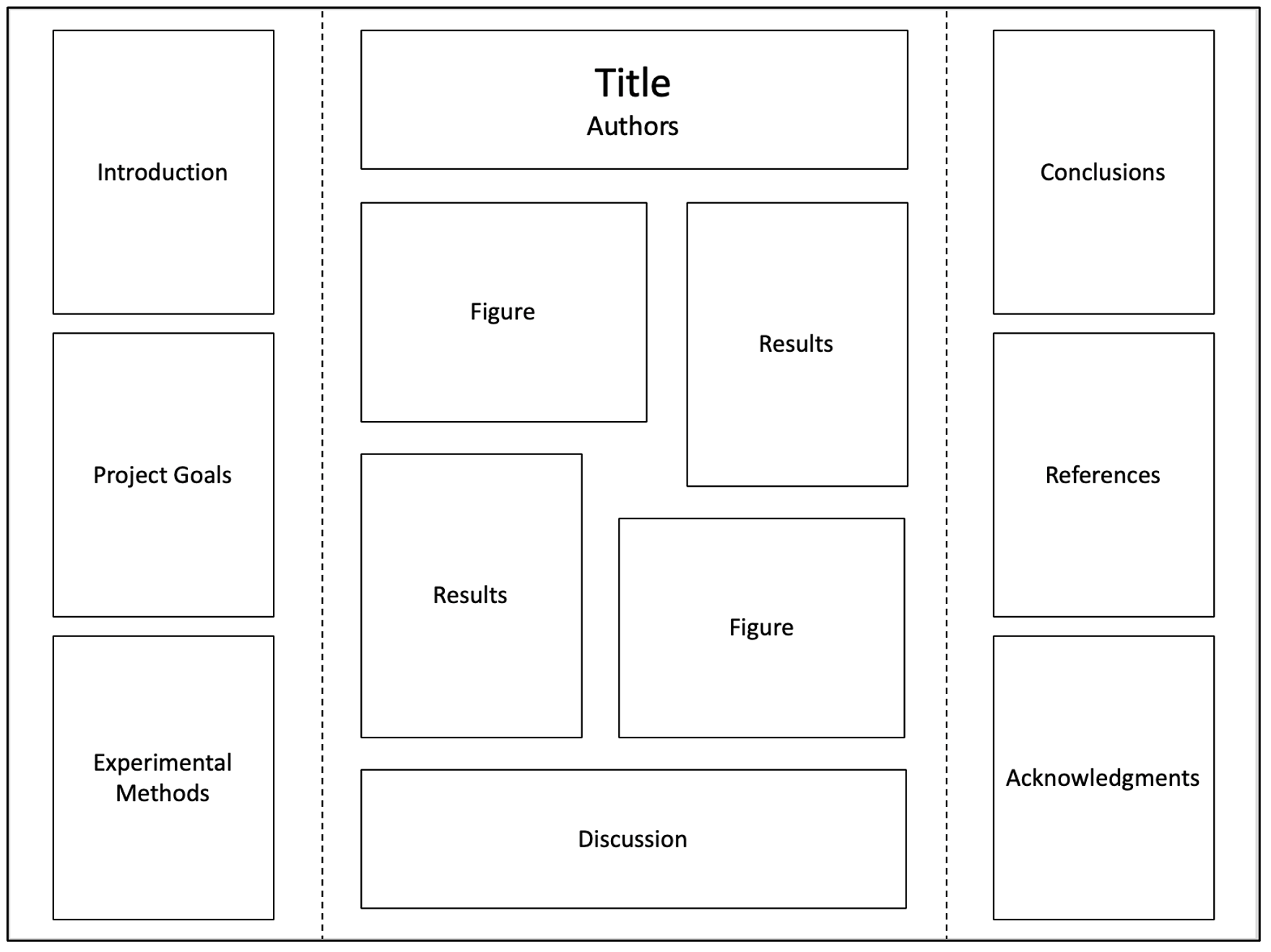Part 7: Assignment Guides
30 Poster Presentations
Scientific posters contain the same components as the formal lab report (Introduction, Methods, Results, Discussion, Conclusion, References) but have less text and typically rely heavily on figures (with suitable captions). The text on a poster should highlight key points so that the audience can get the gist of what you did and discovered just by reading the poster, while the finer details and elaboration are provided by the presenter.
How Should I Present My Poster?
A poster presentation is a very social format for presenting scientific projects. You will have many conversations with many people about the work you did. There are essentially two scenarios that play out during a poster presentation:
- The viewer simply requests, “Tell me about your poster.”
In this situation, many poster presenters will have prepared a “canned speech” about 5 minutes in length to guide the viewer through the poster. This speech tells the story of the project, e.g., “We wanted to investigate X (introduction), so we did Y (methods). Here is what happened (results), and this is what each result meant (discussion). Altogether, the results told us Z (conclusion).” Of course, the presenter would replace X, Y, and Z with the details relevant to the project being presented.
- The viewer asks specific questions about your project.
In this case, you should be prepared to answer any questions relevant to your project.
Possible Formats for Lab Posters
The research poster can be an electronic poster projected on the screen (preferred) or a physical printout that can be pinned to a poster stand or an electronic version projected to the screen. It should be large enough that a small group of viewers can gather in front of your poster to read about what you did and have a conversation with you and your team members about your project.
General Guidelines
- Text Size: Your poster text should be readable from a distance of about 3 feet (for titles, about 10 feet), so be sure to size accordingly. Here are some guidelines:
- Classic Printed Poster Size: 36” x 48”
- Title: 72-120 pt.
- Subtitle: 48-80 pt.
- Section headers: 36-72 pt.
- Body text: 24-48 pt.
- Colors: Like with the size of your text, you should choose colors that make your poster easy to read. For example, you need to provide enough contrast between the text and background; for printed documents, typically you should use a dark text on a light background. Some choose to use light text on a dark background. The visual presentation of text and images of text in the digital resource has a color contrast ratio of at least 4.5:1 for accessibility reasons.
- Images: Images do not rely solely on color to convey information.
Software to Design Your Poster
Guidelines in this document will be based on Microsoft PowerPoint, which is commonly used to make research posters. Other slide presentation programs, such as Apple Keynote or Google Slides, may also work. Alternatively, software for print publications, such as Adobe InDesign, may be used.
Designing a Poster in PowerPoint
- Slide Size: The default slide size is not big enough for a poster. To set the slide size, go to File >> Page Setup and set the Width at 46 inches and the Height at 36 inches. This allows for 1-inch margins on all sides. Your entire poster should be designed in this single slide.
- Consider Using a Template: Research poster templates are available online, such as these free downloads from MSU College of Arts & Letters: Presentation Templates or Colin Purrington: Designing Conference Posters (note that you will have to resize the template to fit our poster bulletin boards; see “Slide Size” above). This may be a good option if your team does not feel comfortable starting from scratch in PowerPoint.
An example poster format is shown below.

Grading
You will be evaluated as a team and as an individual on your participation in the presentation, knowledge of project background, and understanding of the project.
CEM 255 Poster Presentation Success Guide
|
Team & Individual Performance |
||
|---|---|---|
|
Areas to Improve |
Standards for Performance |
Strengths |
|
|
Organization of Content
|
|
|
|
Sides Presentation
|
|
|
|
Presentation Style
|
|
|
|
Responses to Questions
|
|
This chapter was adapted from Erin Duffy’s work for Cooper, M. M. et al Cooperative Chemistry for Michigan State University, 2019.

